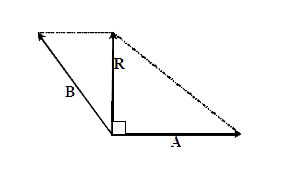The sum and difference of two vectors are perpendicular to each other. Prove that the vectors are equal in magnitude.
To prove that two vectors →A and →B are equal in magnitude given that their sum and difference are perpendicular, we can follow these steps:
Step 1: Define the vectors
Let the two vectors be →A and →B.
Step 2: Write the expressions for the sum and difference
The sum of the vectors is given by:
→S=→A+→B
The difference of the vectors is given by:
→D=→A−→B
Step 3: Use the property of perpendicular vectors
Since →S and →D are perpendicular, their dot product is zero:
→S⋅→D=0
Step 4: Substitute the expressions for →S and →D
Substituting the expressions for →S and →D:
(→A+→B)⋅(→A−→B)=0
Step 5: Expand the dot product
Expanding the left-hand side using the distributive property of the dot product:
→A⋅→A−→A⋅→B+→B⋅→A−→B⋅→B=0
Step 6: Simplify the expression
Since the dot product is commutative (→A⋅→B=→B⋅→A), we can combine the terms:
→A⋅→A−→B⋅→B=0
This simplifies to:
|→A|2−|→B|2=0
Step 7: Conclude the proof
From the equation |→A|2−|→B|2=0, we can conclude that:
|→A|2=|→B|2
Taking the square root of both sides gives:
|→A|=|→B|
Thus, we have proved that the magnitudes of the vectors →A and →B are equal.
Let the two vectors be →A and →B.
The sum of the vectors is given by:
→S=→A+→B
The difference of the vectors is given by:
→D=→A−→B
Since →S and →D are perpendicular, their dot product is zero:
→S⋅→D=0
Substituting the expressions for →S and →D:
(→A+→B)⋅(→A−→B)=0
Expanding the left-hand side using the distributive property of the dot product:
→A⋅→A−→A⋅→B+→B⋅→A−→B⋅→B=0
Since the dot product is commutative (→A⋅→B=→B⋅→A), we can combine the terms:
→A⋅→A−→B⋅→B=0
This simplifies to:
|→A|2−|→B|2=0
From the equation |→A|2−|→B|2=0, we can conclude that:
|→A|2=|→B|2
Taking the square root of both sides gives:
|→A|=|→B|
Thus, we have proved that the magnitudes of the vectors →A and →B are equal.
Topper's Solved these Questions
- BOOK - PRADEEPCHAPTER - KINEMATICSEXERCISE - 4 Very short24videos
KINEMATICS
- BOOK - PRADEEPCHAPTER - KINEMATICSEXERCISE - 5 Very short5videos
KINEMATICS
- BOOK - PRADEEPCHAPTER - KINEMATICSEXERCISE - 2 Very short22videos
KINEMATICS
- BOOK - PRADEEPCHAPTER - GRAVIATIONEXERCISE - Assertion-Reason Type Questions19videos
GRAVIATION
- BOOK - PRADEEPCHAPTER - LAWS OF MOTIONEXERCISE - Assertion- Reason Type Questions17videos
LAWS OF MOTION
Similar Questions
Knowledge Check
- Question 1 - Select One
The sum and diffrence of two perpendicular vector of equal length are
APerpendicular to each other and of equal length.BPerpendicular to each other and of different lengthCOf equal length and have an obtuse angle between themDOf equal length and have an acute angle between them - Question 2 - Select One
Two vectors →P and →Q that are perpendicular to each other are :
A→P=3ˆi+3ˆj+2ˆk,→Q=2ˆi−2ˆj+2ˆkB→P=2ˆi+3ˆj+2ˆk,→Q=2ˆi−2ˆj+2ˆkC→P=2ˆi−3ˆj+2ˆk,→Q=2ˆi−2ˆj−2ˆkD→P=ˆi−3ˆj+2ˆk,→Q=2ˆi−2ˆj+ˆk - Question 3 - Select One
Resultant of two vector of equal magnitude A is
A√3Aat60∘B√2Aat90∘C2Aat120∘DAat180∘
The resultant of two vectors A and B is perpendicular to the vector A and its magnitude is equal to half the magnitude of vector B. The angle between A and B is -
 View Solution
View SolutionA vecto →A has magnitude 2 and another vector →B has magnitude 3. They are perpendicular to each other. By vector diagram, find the magnitude of →A+→B and dhow its direcction in the diagram.
View SolutionState parallelogram law of vectors addition .Find analytcallly the magnitude and direction of resultant vector, When (i) two vectors are parallel to each other (ii) two vectors are perpendicular to each other.
View SolutionThe algebraic sum of two co - initial vectors is 16 units. Their vector sum is 8 units and the resultant of the vectors are perpendicular to the smaller vector. Then magnitudes of the two vectors are -
View SolutionAssertion: The scalar product of two vectors can be zero
Reason: If two vectors are perpendicular to each other their scalar product will be zero.View Solution

